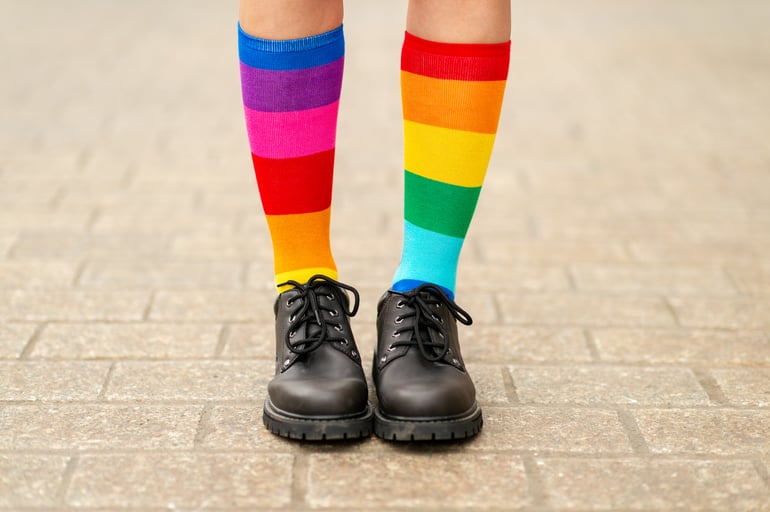
The child welfare system is set up to protect and serve youth who are separated by their legal guardians due to the inability to provide safety, nurturement, or stability. Yet, some adolescents who identify as LGBTQ+ are rejected, neglected, or abused by their family members, forcing them to enter the system. Many of these young people will continue deeper into the system due to disrupted placements, ultimately increasing the risks of childhood trauma.
Hardships LGBTQ+ Teens May Face
When LGBTQ+ youth come out to their friends and families, there can be forms of resistance, confusion, anger, sadness, or other emotions tied to new changes. The sad truth is that 26 percent of LGBTQ+ teens are forced to leave their homes because of conflicts with family members over sexual orientation or gender identity, which, in turn, introduces these youth into the child welfare system. Approximately 22.8 percent of children in out-of-home placements identify as LGBTQ+, which creates the risk of placement instability. Risks of out-of-home placements can include foster care, adoption, living arrangements with various friends or family, and even homelessness. According to Youth.Gov, 46 percent of LGBTQ+ young people experience homelessness, and the chance of these adolescents finding permanent housing is far less likely than that of their straight peers.
On top of housing hardships, LGBTQ+ teens can face discrimination, judgment, rejection, and abuse. According to the Center for the Study of Social Policy, 1 in 5 youth who identify as LGBTQ+ face bullying, and 30 percent of LGBT youth in foster care reported physical violence by family members after sharing their identity. Because of these harsh realities in the child welfare system, LGBTQ+ youth are at great risk for negative life experiences that can include low self-esteem, depression, increased health and mental health challenges, suicide, sexual abuse, drug and alcohol misuse, and involvement with the juvenile justice system. One LGBTQ+ foster youth explained, “I think it would have helped me if I would have known that my foster mom or my foster dad were ok with [my sexuality]. I never knew if I could disclose it and I never did. And that’s where I think a lot of my outlashing, my attitude, my anger, my depression, and my rebellion came from. I felt like nobody understood me. If there was some sort of way for me to know that they were conscious of me and my sexuality and what I’m dealing with, they wouldn’t even have had to sit there and say it, but even just providing the environment and that thought process, I think that would have helped me.”
Transforming the System
After more research and awareness, child welfare professionals are working to fully understand the unique challenges children may face and provide resources to support all youth’s needs, including LGBTQ+ teens. For example, child welfare systems can work with LGBTQ+ youths’ families of origin to support reunification or counseling services.
Furthermore, many organizations and professionals are working together to better support LGBTQ+ teens in the child welfare system and make strides to reduce anti-bias and discrimination. The Children’s Bureau of the Office of the Administration for Children and Families has invested funding in the RISE (Recognize Intervene Support Empower) Initiative of the Los Angeles, CA LGBT Center. This program aims to improve permanency for LGBTQ+ youth in foster care. Initiatives like this one will help transform not only the child welfare system but also other juvenile systems to create safe, welcoming, and inclusive environments for all youth and their families.
A Program All Youth Can Count On
Unfortunately, many LGBTQ+ youths presently face challenges due to their personal preferences and values. Creating awareness of the many hardships LGBTQ+ individuals face in our communities will hopefully allow for counseling services, government branches, juvenile justice, and child welfare systems to expand resources to fit the needs of all children and families.
One program that is proven to work with the whole family is Multisystemic Therapy (MST). MST is an evidence-based intervention for at-risk youth and their families. The MST approach is designed to help families with youth at risk of out-of-home placement in the juvenile justice and child welfare systems. The treatment plans are designed jointly with caregivers and are family-driven rather than therapist-driven and are provided in the context of a household's values, beliefs, and culture. This family and home-based model helps overcome barriers to accessing services, increases the likelihood that families will stay in treatment, provides them with intensive services, and helps maintain treatment gains.
Together, let's make a positive impact by taking the time to listen to youth and their wants, needs, and feelings. In doing so, we can gain an understanding of what they want and need, establish healthy relationships, connect to services and treatments, and work towards transforming communities for our future generations.
To learn more about LGBTQ+ youth and juvenile justice and child welfare system involvement, view our infographic by clicking here.
Multisystemic Therapy (MST) is an evidence-based alternative to incarceration or severe system consequences due to serious externalizing, anti-social, and/or criminal behaviors. MST effectively treats youth and their families by utilizing a built-in suite of services within the home, school, and community settings. Treatment is tailored to the family and their individual strengths and needs which could include but is not limited to the following types of interventions: Family Therapy, Cognitive Behavioral Therapy, Drug and Alcohol treatment, Mental Health Services, Peer Ecology Assessment and Intervention, Trauma-informed treatment, and Educational/ Vocational Support.
If you know of someone that would benefit from MST or you would like to start an MST program in your area, please click here.

